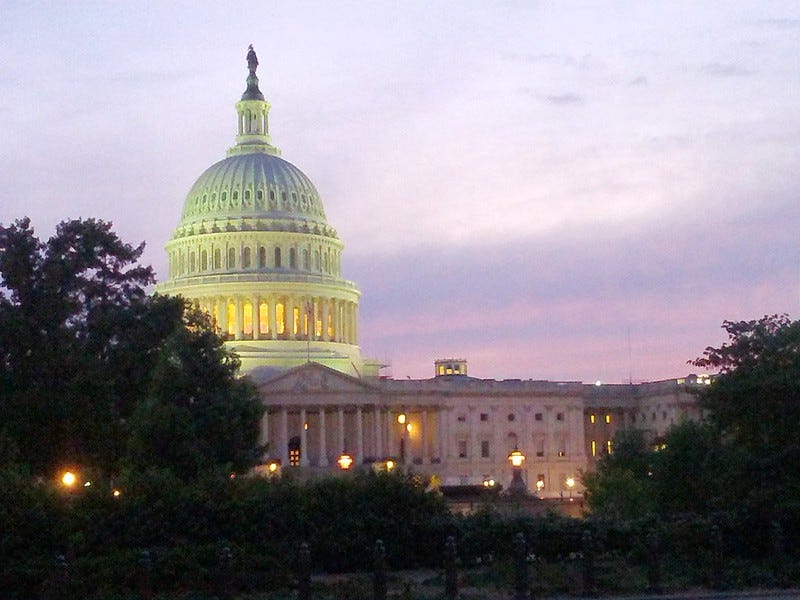Wake Up To Politics - September 29, 2021
Wake Up To Politics: A cheat sheet for the chaos in Congress
Good morning! It’s Wednesday, September 29, 2021. Election Day 2022 is 405 days away. Election Day 2024 is 1,133 days away.
Last night, while scrolling through Twitter, I came across this post from a reporter at Reuters:
I’ve been reporting all week on the complicated jumble of bills and deadlines facing Congress — but this tweet made me wonder if I and my colleagues in the press corps have done all we can to explain what’s going on and why it matters.
This kind of thing is exactly why I started Wake Up To Politics: to help make sure my readers can understand these sorts of complex processes that have far-reaching consequences but aren’t always clearly or directly spelled out in media coverage.
So in that spirit, I’m dedicating today’s newsletter to taking a step back and offering a “cheat sheet” to help you follow the ongoing legislative drama. I’ll give you a refresher on each topic in case you need a reminder of what “BIF” stands for or what a government shutdown is. And if you’re just looking for an update on the latest developments in the negotiations, I’ve got you covered with that too. Let’s dive in...
A cheat sheet for the four-way legislative logjam
Many news outlets — including this one — have called this possibly the most consequential week of the Biden presidency so far, as lawmakers face a cascade of bills and deadlines that each carry huge significance for the American economy and political scene.
But what exactly are the key issues currently before Congress? Here’s a guide to help you understand all four. (If you’re looking for clarity on a specific one, use can jump ahead to infrastructure, reconciliation, government funding, or the debt ceiling.)
Infrastructure
Also known as: The Infrastructure Investment and Jobs Act (the legislation’s official name), BIF (the acronym used by the White House, which stands for “bipartisan infrastructure framework”)
What is it: This is the bipartisan bill that negotiators from both parties toiled over for months and that the Senate passed in a 69-30 vote in August. In total, the package carries a $1.2 trillion price tag, $550 billion of which is new spending and the rest of which renews existing infrastructure spending that is set to expire on Thursday. (It is almost fully paid for, by repurposing unused Covid relief funds and other mechanisms, without raising any taxes.)
Here are some of what will be included by that $550 billion funding boost:
Roads, bridges, and major infrastructure projects ($110 billion)
Power infrastructure ($73 billion)
Passenger and freight rail ($66 billion)
Broadband infrastructure ($65 billion)
Clean drinking water ($55 billion)
Public transit ($39 billion)
Airports ($25 billion)
Electric vehicles ($7.5 billion)
Although the package is quite a bit smaller than what President Biden originally proposed, it is still the largest federal investment in public transit in U.S. history, the largest federal investment in passenger rail since the founding of Amtrak, and the largest federal investment in bridges since the advent of interstate highways.
The measure also combines two of Biden’s top priorities (rebuilding the nation’s infrastructure and reviving bipartisanship in Washington), which is why it was a huge win for him when it passed the Senate by a wide margin and why he is so intent on pushing it through the House as well.
Where things stand: The bipartisan package only has one more stop — passage in the House — before it lands on Biden’s desk. But gaining House approval has been complicated by the reconciliation process that is going on at the same time (see below). The reconciliation process contains many of the liberal priorities left out of the bipartisan bill, and progressive Democrats want the reconciliation bill to pass first before they allow the bipartisan bill to go through. Moderate Democrats, meanwhile, are pushing for the bipartisan package to get approval ASAP.
House Speaker Nancy Pelosi (D-CA) has effectively sided with the moderates, announcing that the infrastructure package will be put to a vote on Thursday. She is gambling that progressives won’t sink a key Biden priority — but, right now, it’s looking like she might be wrong. According to a statement by the Congressional Progressive Caucus, a majority of its 96 members are prepared to vote “no” tomorrow, saying they will only vote for the bipartisan bill once the reconciliation package has passed as well.
Although it passed the Senate with support from both parties, fewer than a dozen House Republicans are expected to support the measure — which won’t be enough to save it if progressives follow through on their threats. That means Pelosi will either have to win over progressives by proving the reconciliation process is moving ahead (even if the full package hasn’t passed yet), postpone the vote on the bipartisan bill, or watch it go down in flames tomorrow.
Reconciliation
Also known as: The Build Back Better Act (the legislation’s official name), the Democratic spending package
What is it: This is the mega-bill Democrats are using to push through everything that got left out of the bipartisan infrastructure package. As some Democrats have put it, the bipartisan bill contains the “physical infrastructure” element of Biden’s agenda while this package will cover the “human infrastructure” side: things like education, health care, and other priorities.
To pass it, Democrats are using the budget reconciliation process, a complicated maneuver that basically allows them to pass a package through Congress without it being subject to a Senate filibuster (meaning it only needs support from all 50 Democrats, as opposed to 60 senators).
The package is still being fiercely negotiated, and could end up being a lot smaller, but the price tag being pushed by Democratic leaders is $3.5 trillion. Democrats plan to pay for most of the package through a suite of tax increases, including hiking the corporate tax rate and the top individual tax rate and closing various loopholes used by wealthy Americans to avoid paying taxes.
Again, this is all subject to change — but here are the main priorities Democrats hope will end up in the reconciliation package:
Two years of universal pre-K and two years of tuition-free community college for all Americans
An expansion of Medicare to cover dental, hearing, and vision
12 weeks of guaranteed paid family and medical leave
Tax credits for children and for elder care
Initiatives to cut down on greenhouse gas emissions
One important thing to keep in mind is that there are specific rules that govern the reconciliation process (most notably the “Byrd Rule”). It is up to Senate Parliamentarian Elizabeth MacDonough to decide what can stay in and what can’t. MacDonough has already ruled that Democrats can’t extend a pathway to citizenship to certain undocumented immigrants in the bill, although the party plans to offer an alternative they hope she will accept.
Where it stands: As I said before, Democrats are counting on there being progress on the reconciliation bill before the infrastructure bill advances. But the problem is that there hasn’t been much progress on the reconciliation bill. There are no Republicans involved in this process, so that’s all because of a widening split between Democratic lawmakers.
The two lawmakers at the center of it are Sens. Joe Manchin (D-WV) and Kyrsten Sinema (D-AZ). Both senators want a package that is smaller than $3.5 trillion, but they’ve so far declined to offer a topline number they’d be more comfortable with. They each met separately with President Biden on Tuesday; it does not seem like those meetings yielded any more specifics on what the centrists would and wouldn’t allow in the package.
So that leaves Democrats at a standstill, and increasingly frustrated with “Manchinema.” Until the duo offers more clear directions on what they’d vote for in the Senate, the reconciliation bill is going nowhere. And, if progressives are to be believed, if the reconciliation bill is going nowhere, the infrastructure package is too.
Government funding
Also known as: The continuing resolution (or “CR” for short)
What it is: At the same time as Democrats are scrambling to pass their two main legislative priorities, a government shutdown is also looming. The federal government’s new fiscal year always begins on October 1 — which means Congress must pass the annual appropriations bills by then to set next year’s spending levels for government agencies. None of the appropriations bills have been passed, so lawmakers must act by midnight Thursday (the end of the fiscal year) to pass a continuing resolution that would keep spending at its current levels.
If Congress doesn’t pass a CR today or tomorrow, the government has no funding and it shuts down. What happens then? All non-essential government employees are furloughed and many government operations would halted until a CR is approved. In past government shutdowns, that has meant shuttered national parks have been closed, problems distributing food stamps, delays at the IRS, among other consequences. (Programs like Medicare and Social Security are not affected.)
Where things stand: Last week, the House passed a CR that would extend government funding through December 3 of this year, while also lifting the debt ceiling through December 2022. The plan passed along party lines, and was blocked by a Republican filibuster in the Senate, because of GOP objections to the debt ceiling suspension (see below).
Democrats are almost certain to surrender and offer a “clean CR” — with no debt ceiling hike attached — next. Both the House and Senate are expected to vote as early as today to approve the CR, which also includes $6.3 billion to fund relocation of Afghan refugees and $28.6 billion in aid for states impacted by Hurricane Ida.
Debt ceiling
Also known as: The debt limit
What it is: If you’re looking for a detailed explanation of the debt ceiling and its history, I wrote one last week that you should take a look at. But to quickly review: The debt ceiling is the limit on how much the federal government can borrow, which it needs to do to finance its various expenditures and operations. The government technically hit that limit in August, but the Treasury has been using “extraordinary measures” to keep paying its bills.
Treasury Secretary Janet Yellen told lawmakers on Tuesday that the actual deadline when the government will exhaust those measures is October 18. If the debt ceiling isn’t lifted by then, the U.S. will default on its debt for the first time in its history. Most economists say that would trigger a global financial crisis and could hamper faith in the government’s credit rating for generations to come. According to a report by Moody’s Analytics, a debt default would lead to a 6 million U.S. jobs being lost and $15 trillion in household wealth being wiped away in an ensuing stock market crash.
Where things stand: Although the debt ceiling has been raised on a bipartisan basis dozens of times in the past, Senate Minority Leader Mitch McConnell (R-KY) has said the onus is squarely on Democrats to do it on their own this time. McConnell’s reasoning is that Democrats are in complete control of the House, Senate, and presidency — and are already using the reconciliation process to spend trillions of dollars, so they should use the same process to lift the debt ceiling.
Democrats respond by citing past examples of bipartisan cooperation on the debt ceiling (most recently in the Trump era) and pointing to the fact that the debt ceiling would not cover new spending, only what has already been authorized (again, largely in the Trump era). However, those arguments don’t seem to be getting anywhere: the Senate GOP voted down the combined debt ceiling/CR last week, and then McConnell blocked a Democratic attempt to advance a clean debt ceiling bill by majority vote on Tuesday — insisting that Democrats raise the limit alone, but also that they only do it through the reconciliation process.
The next steps here are unclear. The House will likely vote on a clean debt ceiling bill today — but it may not even pass the House, and it will certainly fail in the Senate. So will Democrats use reconciliation? It depends on who you ask. Senate Majority Leader Chuck Schumer (D-NY) called the idea a “nonstarter” on Tuesday, but other Democratic lawmakers have admitted that it is probably their only hope of avoiding a default. Going through the reconciliation process can be laborious, however, so we might be looking at several more weeks where the default threat will be hanging over Washington.
I hope that helps you understand the tangled knot of issues currently before your representatives in Washington. Do you still have questions? Feel free to drop me a line at gabe@wakeuptopolitics.com.
Daybook
All times Eastern, unless otherwise noted.
WHITE HOUSE
President Joe Biden will receive his daily intelligence briefing at 9:30 a.m. Later, he will attend the memorial service of Susan Bayh, the wife of former Indiana Sen. and Gov. Evan Bayh, at the Washington National Cathedral at 12 p.m.
Vice President Kamala Harris will hold a meeting with small business leaders at 2 p.m. to discuss the bipartisan infrastructure deal and the “Build Back Better” package.
White House Press Secretary Jen Psaki will hold her daily press briefing at 2 p.m.
CONGRESS
The Senate will convene at 9:30 a.m. Later, the chamber will vote at 10:30 a.m. on the confirmation of Jessica Lewis to be Assistant Secretary of State for Political-Military Affairs. At 2:30 p.m., the Senate will hold a cloture vote to advance the nomination of Robert Anderson to be Solicitor of the Labor Department, followed by a cloture vote to advance the nomination of Eugene Meyer to be General Counsel of the Department of Homeland Security.
The House will convene at 10 a.m. The chamber is scheduled to vote under “suspension of the rules” on seven pieces of legislation:
H.R. 4611, the DHS Software Supply Chain Risk Management Act
H.R. 4089, the Darren Drake Act
S. 1917, the K-12 Cybersecurity Act
H.R. 4094, the One-Stop Pilot Program Act
H.R. 4682, the UAS Act
H.R. 4426, the Homeland Security for Children Act
H.R. 4363, the DHS Contract Reporting Act
The chamber may also hold votes on separate pieces of legislation to extend government funding and suspend the debt ceiling.
Democratic and Republican lawmakers will take their competition to the baseball field at 7 p.m. to play in the Congressional Baseball Game, an annual D.C. tradition that dates back to 1909 and raises money for a collection of local charities.
CONGRESSIONAL COMMITTEES
The House Armed Services Committee will hold a hearing at 9:30 a.m. on the U.S. withdrawal from Afghanistan. The panel will hear testimony from Defense Secretary Lloyd Austin; Gen. Mark Milley, the chairman of the Joint Chiefs of Staff; and Gen. Kenneth McKenzie, the commander of U.S. Central Command.
The Senate Judiciary Committee will hold a hearing at 10 a.m. on Texas’ new abortion law and the Supreme Court “shadow docket,” which the court used to decline a challenge to the law. Witnesses will include state Rep. Donna Howard (D-TX) and Alabama Solicitor General Edmund LaCour, a former Trump judicial nominee.
COURTS
The Supreme Court is not in session.
Thanks for waking up to politics! If you enjoy reading this newsletter, I’d be so grateful if you’d consider donating to help support me and my work. If you want to show off your support for Wake Up To Politics, you can also buy some merchandise.
Also: don’t forget to tell your friends and family to sign up for the newsletter using your unique referral link. And if you have any questions or comments, feel free to email me at any time.










